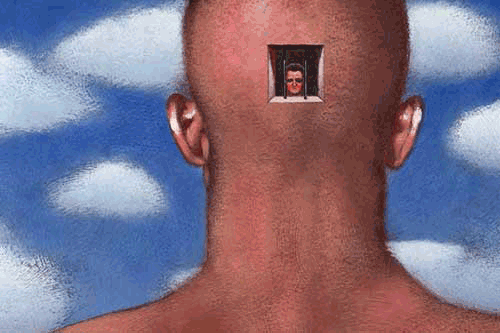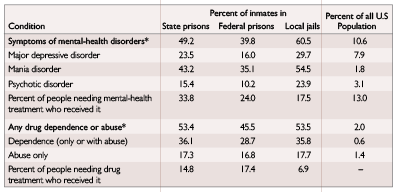Incarceration and Community Health 
Poverty, illiteracy, and harsh sentences for minor offenses often result in prisons full of poor minorities. Those suffering from addictions could be treated more effectively in communities.
The United States incarcerates a higher percentage of its residents than any other country. With less than 5 percent of the world's population, it has almost 25 percent of the world's prisoners. In 2010, one of every 31 U.S. adults was either in prison or on probation or parole.[1] The rate jumps to one in 11 for black men, and is even higher in poor, urban neighborhoods.
Most of the post-1970s explosion consists of low-level, nonviolent offenders, the majority suffering from medically recognized illnesses. The War on Drugs and a failure to treat mental illness, addiction, and drug dependence adequately in the community have driven the incarceration epidemic. And because the effects of incarceration (absentee parents, lack of future employment options, persistent addiction) are concentrated in low-income neighborhoods, community health suffers, too.[2]

Illustration: Corbis
Two Main Causes
Two overlapping phenomena account for most of the rise in incarceration: deinstitutionalization of the mentally ill and increasingly harsh sentences for drug use. The nation's three largest psychiatric facilities are in jails (in Los Angeles, Chicago, and New York City). According to surveys conducted in 2002 and 2004, more than half of all prison inmates (two-thirds of people in local jails) suffer from mental-health problems. (See "Mental-Health and Drug Issues among Prisoners.") Prisoners are five times more likely to have mental-health disorders than the general public, with even higher rates for serious mental illnesses.[3]
The number of people incarcerated for drug crimes in 1980 (40,000) had swelled to almost 500,000 by 2008.[4] Most aren't key players.[5] In 2010, for example, about 80 percent of drug offenders were charged only with possession (frequently marijuana). The vast majority are black or Hispanic and poor, and although drug usage is comparable across racial and ethnic populations, blacks and Hispanics are more likely than whites to be in prison for drug crimes.[6] In Massachusetts, for example, nonwhites were 20 percent of the state's population in 2006 but 54 percent of those convicted of drug crimes. They represented almost 75 percent of those sentenced to incarceration.[7]
In 2010, U.S. "drug czar" Gil Kerlikowske admitted the War on Drugs had not succeeded.[8] Despite tough policies, from 2004 to 2010, the number of illicit drug users actually rose from 19.1 million to 22.6 million.[9] The "war" had succeeded only in incarcerating more people who were drug dependent or drug abusing--recognized disorders.
Mental-Health and Drug Issues among Prisoners, 2002 and 2004
Mental-health disorders, drug dependence, and drug abuse among inmates in state and federal prisons (2004) and local jails (2002), compared with the noninstitutionalized population

Sources: Survey of Inmates in State and Federal Correctional Facilities (2004) and Survey of Inmates in Local Jails (2002), Bureau of Justice Statistics. See also http://www.oas.samhsa.gov/nhsda/2k2nsduh/results/2k2Results.htm#chap8.
*Based on criteria specified in the Diagnostic and Statistical Manual of Mental Disorders, 4th edition
More Cost-Effective Ways
Using incarceration to prevent drug use is inefficient, ineffective, and expensive. In Massachusetts, incarcerating a drug user in state prison costs $48,000 annually and doesn't cure the individual or benefit society. Treatment benefits both.[10] Offenders who receive treatment are less likely to reoffend; their rates of employment increase; their health improves. Successful treatment is cost-effective, reducing government spending for health care, criminal justice, and social services. Treatment can reduce crime rates by 80 percent and reduce arrests by 64 percent.[11] According to the State Associations of Addiction Services, taxpayers save $7 for every $1 spent on treatment.
Compounding the issue is the relation between health and socioeconomic status and race. Low-income people, blacks, and Hispanics generally have worse health outcomes than Caucasians and higher-income people.[12] Except in Massachusetts, the poor often lack health insurance, especially single, unemployed, or underemployed individuals who don't qualify for Medicaid. Prisoners from communities lacking good health-care access have high rates of illness, including mental illness and addiction.[13] A 2002 report in Massachusetts found that 80 percent of chronically ill prisoners had not received regular medical care prior to incarceration, 90 percent had no health insurance, and more than half relied on emergency rooms when not in prison.[14]
About 600,000 people leave state or federal prison annually; 7 million leave local jails. What happens with the 95 percent of all inmates who are released and returned to communities? Even though the U.S. Supreme Court mandates that inmates be provided necessary medical care, few will have received it, especially if they suffer from mental illness or addiction.[15] Even when adequate care is provided inside, release generally means returning to poverty and limited health options. According to one national study, 68 percent of the men released and 58 percent of the women are uninsured and unable to afford care.[16]
Diverting low-level drug offenders to treatment instead of incarceration is cost saving and humane. The Massachusetts Bar Association's 2009 Drug Crimes and Incarceration Rates in the Commonwealth estimated that net savings of diverting one drug offender sentenced to less than four months at a cost of $11,700 would amount to $4,620 after costs for treatment and probation. In 2006, for example, diverting 1,426 possession offenders with nonviolent criminal histories would have resulted in net savings to the Commonwealth of over $8 million.
Recently released prisoners often neglect their health as they struggle to find housing and work, and to rebuild families. Jobs for ex offenders are few, and lack of earnings may result in a return to illegal activities. Moreover, in most states, a felony drug conviction eliminates or limits eligibility for public assistance, including food stamps, welfare, and student loans. A convicted murderer or rapist with no drug record would generally not face similar penalties.
U.S. policies hinder the delivery of medical care to low-income and incarcerated individuals. A key step in improving the situation would be to increase medical treatment in both community and correctional settings. Politicians have begun to recognize the unsustainability of the current system and the potential savings from additional community- based treatment.[17] The proposed expansion of Medicaid in 2014 would permit virtually all former prisoners to receive health-care coverage, potentially redirecting individuals with serious illnesses away from the revolving door of the criminal justice system while decreasing costs and improving public health in low-income communities.
Brad Brockmann, JD, is executive director of the Center for Prisoner Health and Human Rights in Providence.
Josiah D. Rich, MD, MPH, director and co-founder of the center, is a professor of medicine at Brown University.
Endnotes
[1] Pew Center on the States, One in 31: The Long Reach of American Corrections (Washington, DC: Pew Charitable Trusts, March 2009), http://www.pewcenteronthestates.org/uploadedFiles/PSPP_1in31_report_FINAL_WEB_3-26-09.pdf .
[Return to endnote in story]
[2] L. Wacquant, "Class, Race, and Hyperincarceration in Revanchist America," Daedalus (summer 2010); M.Massoglia, "Incarceration, Health, and Racial Disparities in Health," Law & Society Review 442, no. 2 (2008).
[Return to endnote in story]
[3] These statistics do not include prisoners too mentally ill or otherwise incapable of completing the questionnaires.
[Return to endnote in story]
[4] Adam Liptak, "U.S. Prison Population Dwarfs That of Other Nations," New York Times, April 23, 2008.
[Return to endnote in story]
[5] Crime in the United States 2010 (Washington, DC: Federal Bureau of Investigation, 2010), http://www.fbi.gov/about-us/cjis/ucr/crime-in-the-u.s/2010/crime-in-the-u.s.-2010 .
[Return to endnote in story]
[6] Michelle Alexander, The New Jim Crow: Mass Incarceration in the Age of Colorblindness (New York: The New Press, 2010); and Bruce Western, Punishment and Inequality in America (New York: Russell Sage Press, 2006).
[Return to endnote in story]
[7] Drug Crimes and Incarceration Rates in the Commonwealth (Boston: Massachusetts Bar Association, April 29, 2009).
[Return to endnote in story]
[8] Andre M. Davis, "Mandatory Minimum Sentences Impede Justice," Baltimore Sun, December 8, 2011.
[Return to endnote in story]
[9] 2010 National Survey on Drug Use and Health: National Findings (Washington, DC: U.S. Dept. of Health and Human Services, 2011).
[Return to endnote in story]
[10] National Institute of Drug Abuse, Principles of Drug Abuse Treatment for Criminal Justice Populations (Bethesda, Maryland: National Institutes of Health, 2007); and D. McVay et al., Treatment or Incarceration? National and State Findings on the Efficacy and Cost Savings of Drug Treatment vs. Imprisonment (Washington, DC: Justice Policy Institute, 2004).
[Return to endnote in story]
[11] Open Society Foundations, Defining the Addiction Treatment Gap: Data Summary, http://www.soros.org/initiatives/treatmentgap/articles_publications/publications/data-summary-20100916/datasummary-20101123.pdf .
[Return to endnote in story]
[12] N.B. Anderson et al., eds., Critical Perspectives on Racial and Ethnic Differences in Health in Late Life (Washington, DC: National Academies Press, 2004).
[Return to endnote in story]
[13] J.D. Rich et al., "Medicine and the Epidemic of Incarceration in the United States," New England Journal of Medicine 364, no. 22 (June 2011).
[Return to endnote in story]
[14] T.J. Conklin et al., A Public Health Manual for Correctional Health Care (Ludlow, Massachusetts: Hampden County Sheriff 's Department, 2002); R. Kohl et al., Massachusetts Recidivism Study: A Closer Look at Releases and Returns to Prison (Washington, DC: Urban Institute and the Massachusetts Department of Corrections, April 2008).
[Return to endnote in story]
[15] Brown v. Plata, 563 U.S. (2011); and Estelle v. Gamble, 429 U.S. 97(1976).
[Return to endnote in story]
[16] K. Mallik-Kane and C.A. Visher, Health and Prisoner Reentry: How Physical, Mental, and Substance Abuse Conditions Shape the Process of Reintegration (Washington, DC: Urban Institute, 2008).
[Return to endnote in story]
[17] N. Gingrich and P. Nolan, "Prison Reform: A Smart Way for States to Save Money and Lives," Washington Post, January 7, 2011.
[Return to endnote in story]
Articles may be reprinted if Communities & Banking and the author are credited and the following disclaimer is used: "The views expressed are not necessarily those of the Federal Reserve Bank of Boston or the Federal Reserve System. Information about organizations and upcoming events is strictly informational and not an endorsement."

 About the Authors
About the Authors
Brad Brockmann, Center for Prisoner Health and Human Rights
Josiah D. Rich, Center for Prisoner Health and Human Rights



